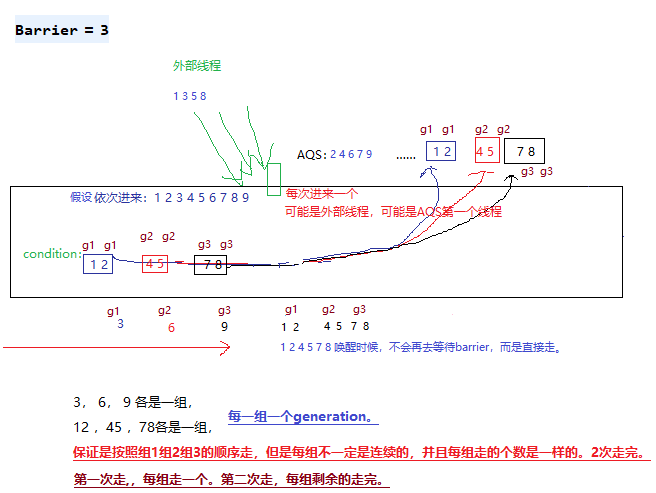![]()
![]()
public class CyclicBarrierExample3 {
private static CyclicBarrier1 barrier = new CyclicBarrier1(3, new Runnable() {
@Override
public void run() {
System.out.println("callbakck ISIrunning");
}
});
public static void main(String[] args) throws Exception {
for (int i = 0; i < 10; i++) {
/* Thread t = */new Thread(new Runnable() {
@Override
public void run() {
try {
barrier.await();
System.out.println(Thread.currentThread().getName());
} catch (Exception e) {
e.printStackTrace();
}
}
},"线程"+(i+1)).start();
}
}
}
public class CyclicBarrier1 {
//一次等待中,有一个generation和count。不同的组等待generation不同。
private volatile static int i;
private static class Generation {//表示一组,
boolean broken = false;//一组等待是否坏了
String name = "g"+(++i);
}
private final int parties;//线程等待数量,不变
private int count;//等待线程数,减一,会变,剩余等待数量
private Generation generation = new Generation();//每一组一个generation
private final ReentrantLock1 lock = new ReentrantLock1();//非公平锁
private final Condition trip = lock.newCondition();
private final Runnable barrierCommand;//执行函数
private void nextGeneration() {//线程等待数量够了,唤醒所有线程,并在重新初始化一个generation
//第3个线程来signalAll,第1第2个线程会从condition队列移到AQS队列去,
//第3个线程来unlock,第1第2线程不一定会进来执行(因为AQS队列前面可能还有别的线程)。
//第3个线程unlock,只是允许外部线程或者AQS中的线程或者condition加到AQS中的线程,唤醒一个进来。
trip.signalAll();
count = parties;//parties不会变化,count会减减,这里重置count等着下一次的等待用。
generation = new Generation();//重新初始化generation
}
private void breakBarrier() {//
generation.broken = true;// 这一组异常,会影响后面不是一组的线程。
count = parties;//重置count
trip.signalAll();//唤醒所有,condition加到AQS去。
}
//多线程访问
private int dowait(boolean timed, long nanos) throws Exception {
final ReentrantLock1 lock = this.lock;
lock.lock();
//进来的是AQS中的(包括condition移过去的)
try {
//每一组一个g,nextGeneration()会新建generation。如果改变了,这个线程使用的是上组中最后线程改变的generation。
final Generation g = generation;
// if(Thread.currentThread().getName().equals("线程4")
// || Thread.currentThread().getName().equals("线程9")) {
// Thread.currentThread().interrupt();
// }
if (g.broken)//generation不会被改变
throw new BrokenBarrierException();
if (Thread.interrupted()) {// 线程中断,
breakBarrier();//broken = true; 不会改变generation,后面进来的线程都使用这个generation,直接跑异常。
throw new InterruptedException();
}
int index = --count;//数量减一,index保存在线程栈中,
if (index == 0) { //释放所有线程
boolean ranAction = false;
try {
final Runnable command = barrierCommand;
if (command != null)
command.run();
ranAction = true;
//只有一组中,最后进来的线程 改变generation。后面进来的线程属于另一组。generation由上一组中最后进来的线程修改。
nextGeneration();//唤醒所有等待线程,重置count和generation。注意这里没有释放锁, 新建一个generation。
return 0;
} finally {
if (!ranAction)//ranAction=false进去
breakBarrier();//broken = true;
}
}
// 死循环直到 唤醒, broken, 中断, 超时
for (;;) {
try {
// if(Thread.currentThread().getName().equals("线程4")
// || Thread.currentThread().getName().equals("线程9")) {
// throw new Exception();
// }
if (!timed)//是否有超时
trip.await();//线程转移到Condition上等待,并且head唤醒AQS下一个节点。
else if (nanos > 0L)
nanos = trip.awaitNanos(nanos);//等待时间
} catch (InterruptedException ie) {
if (g == generation && ! g.broken) {
breakBarrier();//设置broken=true,重置count,condition加到AQS去。
throw ie;
} else {
Thread.currentThread().interrupt();
}
}
if (g.broken)//true
throw new BrokenBarrierException();
// g != generation表示正常换代了,返回当前线程所在栅栏的下标
// 如果 g == generation,说明还没有换代,那为什么会醒了?
// 因为一个线程可以使用多个栅栏,当别的栅栏唤醒了这个线程,就会走到这里,所以需要判断是否是当前代。
// 正是因为这个原因,才需要generation来保证正确。
if (g != generation)
return index;//返回
if (timed && nanos <= 0L) {
breakBarrier();//
throw new TimeoutException();
}
}
} finally {
lock.unlock();//外部线程或者AQS中的线程或者condition加到AQS中的线程,唤醒一个进来。
}
}
public CyclicBarrier1(int parties, Runnable barrierAction) {
if (parties <= 0) throw new IllegalArgumentException();
this.parties = parties;//等待线程数
this.count = parties;//等待线程数
this.barrierCommand = barrierAction;
}
public CyclicBarrier1(int parties) {
this(parties, null);
}
public int getParties() {
return parties;//parties不变
}
public int await() throws Exception, BrokenBarrierException {
try {
return dowait(false, 0L);
} catch (TimeoutException toe) {
throw new Error(toe); // cannot happen
}
}
public int await(long timeout, TimeUnit unit) throws Exception, BrokenBarrierException, TimeoutException {
return dowait(true, unit.toNanos(timeout));
}
public boolean isBroken() {
final ReentrantLock1 lock = this.lock;
lock.lock();
try {
return generation.broken;
} finally {
lock.unlock();
}
}
public void reset() {
final ReentrantLock1 lock = this.lock;
lock.lock();
try {
breakBarrier(); //
nextGeneration(); //
} finally {
lock.unlock();
}
}
public int getNumberWaiting() {
final ReentrantLock1 lock = this.lock;
lock.lock();
try {
return parties - count;
} finally {
lock.unlock();
}
}
}







 浙公网安备 33010602011771号
浙公网安备 33010602011771号